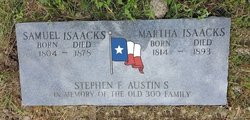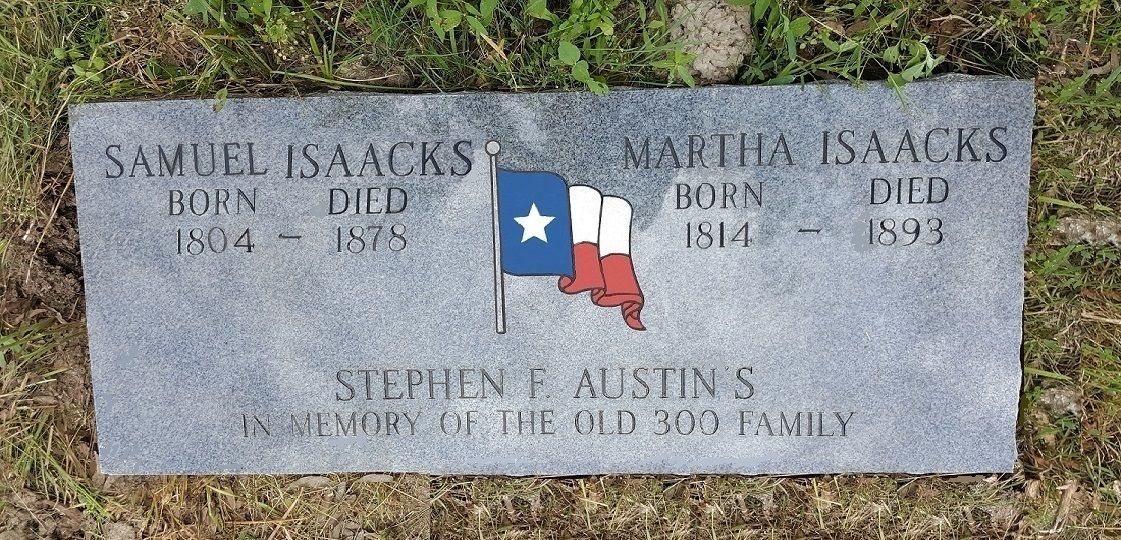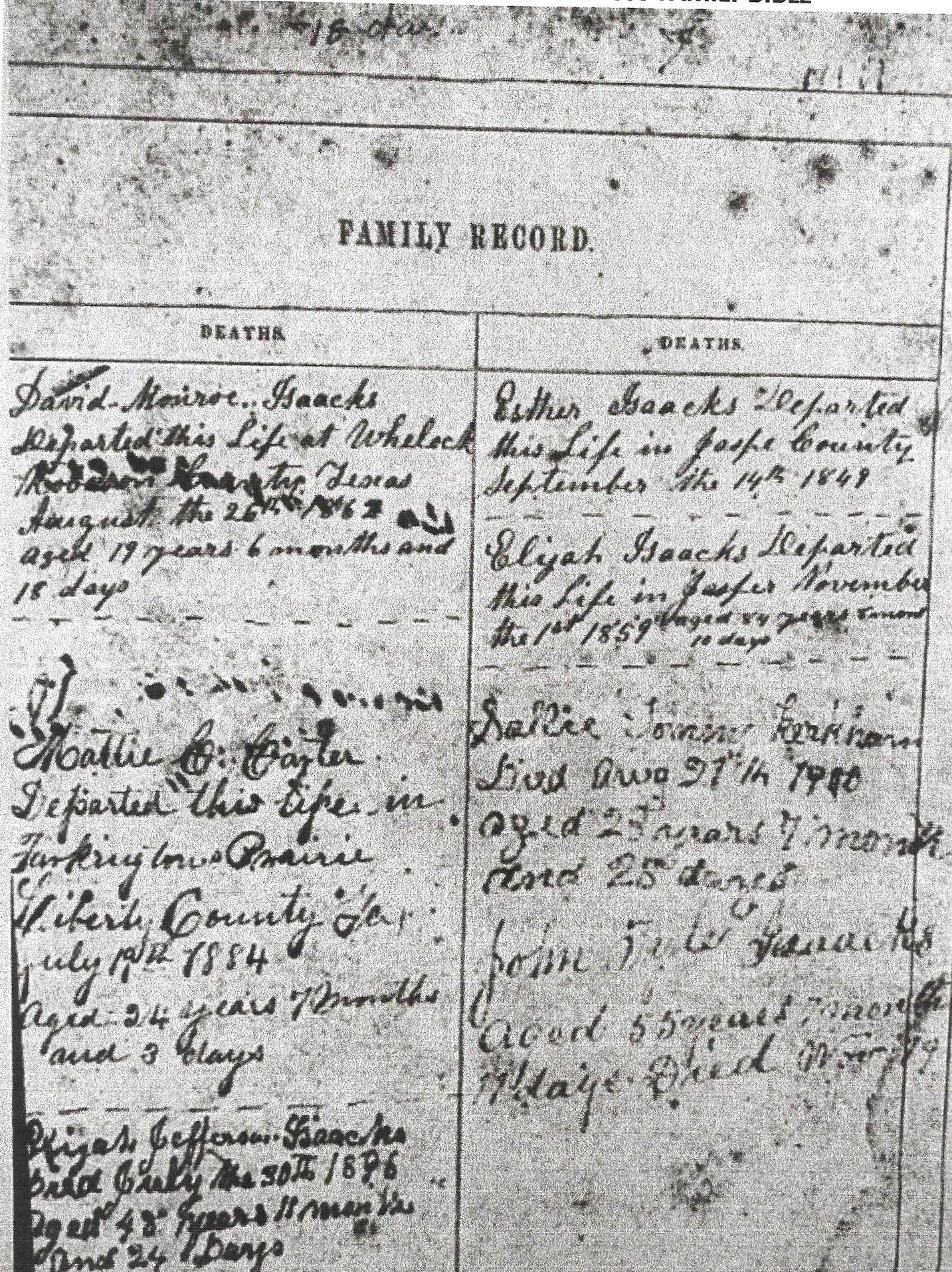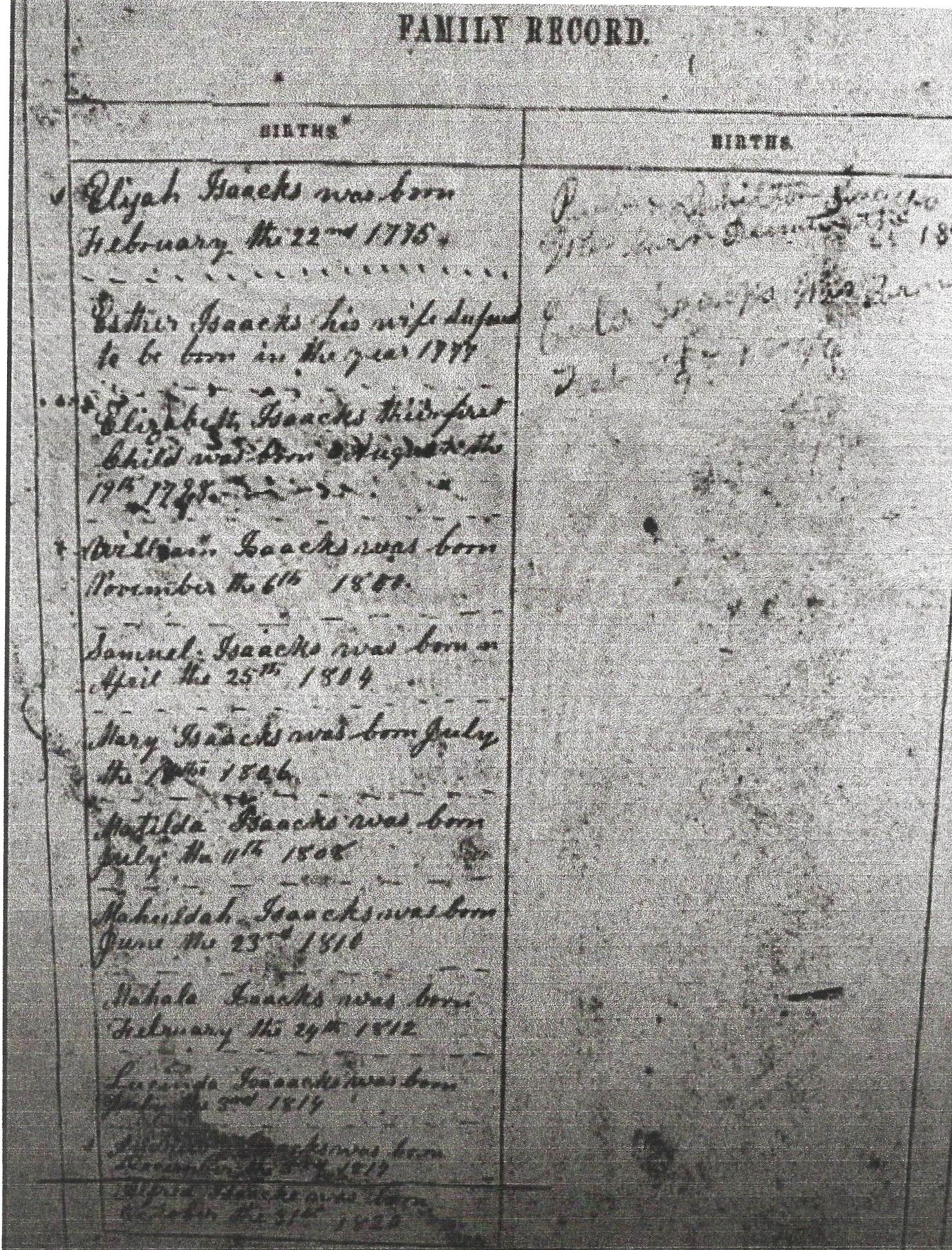Samuel Isaacks married two times; 1st Nancy ALLEN With whome he had two children,Nancy died shortly after the birth of their second son John Leroy Isaacks; 2nd Samuel married Martha "Patsy" Richardson.(Note:In his history nothing is said about the first family so they may have all died prior to him moving or been taken in by other family when he moved.
NOTE: he and his wife were re-interred in this cemetery from their old home place.
..................
"Samuel III was one of Austin's "Old 300" as shown by the Land Office archives; he was also a soldier in the Texas Revolution, and my father often told me that he was at the Battle of San Jacinto, although the records do not substantiate this. There can be, however, no question but that he was in the Army at the time of this battle, but I have been unable to find a record of his first enlistment. He was listed as a first class veteran, which means that he served in 1836, prior to the establishment of the permanent Government. The Comptroller's military record No. 7702, in the Texas State Library, shows his discharge, signed by John Ingram, Capt. Jasper Volunteers. The fact that he was one of the Jasper Volunteers indicates that in 1836 he probably resided in Jasper County, the home of his father. Evidently, he did not live many years on his original grant in Fort Bend County. His oldest son, Wesley, was born May 31, 1832, in what is now Angelina County. This county adjoins Jasper, and no doubt he moved there sometime prior to "32, to be in the same part of the country as his father, Elijah. About 1850, he purchased 200 acres of land at Lynchburg, in Harris County, just across the San
Jacinto River from the battleground. This land was acquired, at least in part, for the purpose of building wharves and private shipping and loading facilities. Lynchburg was at that time the head of navigation of the San Jacinto. Cold Spring, nearly 100 miles North, in San Jacinto County, was the center and trading point of a very well developed agricultural region, and he conceived the idea of opening up a road between the two points, and establishing a freight line. This he did, and one knowing the character of the country traversed, with its heavy timber and undergrowth, as well as the many streams, will realize what a tremendous undertaking it was. He opened up and operated this line with ox teams for a number of years, but opening up of navigation through Buffalo Bayou to Houston and other roads, put him out of business. He continued to reside at Lynchburg until after the Civil War, when he sold his holdings there and purchased a tract of some 300 acres on Taylor's Bayou, near Galveston Bay, a short distance from where the Bayou enters into the Bay, and three or four miles Northwest from the present town of Seabrook. He lived there until his death in 1878, and was buried under a live oak tree a few hundred yards from his home on the homestead tract. He had lived in Tennessee, the State of his birth, Mississippi, the Republic of Mexico, the Republic of Texas, which he helped to establish, the State of Texas, as one of the American Union, the Southern Confederacy, and again in the United States of America. Among his friends he numbered scores of the Texas veterans, and among them a few leaders, notably Sam Houston and General Ed Burleson, for the latter of whom he named one of his sons.
When I was six or seven years old our family made an extended visit of several months to his Taylor's Bayou home, and my recollection of him and the home place is rather vivid. As I remember him, he was probably six feet tall, "raw-boned," or stalwart, and very active for a man more than 72 years old. He was fond of children, especially boys, and he took delight in instructing me in many things connected with the farm and livestock, and especially in woodcraft. To my childish mind he was the man of perfection, both physically and intellectually. In about two years after our return to the West a letter came announcing his death, and for days my grief was intense. His wife, Martha, it seemed to me as a boy, was a remarkable woman, and I never changed my mind when I grew to maturity. She lived until 1893, nearly 80 years, and while she made her home at or near Houston, after grandfather's death she frequently visited in our home, some 200 miles West. I can now recall how, on her first visit, she talked of her fear of the train and her dread of the journey. At that time not so many people in Texas had ridden the railroad cars. Small of stature, probably never balancing the scales at as much as 100 pounds, she was one of the most kindly and motherly souls. One of my sweetest memories is when she held me on her lap and sang "The Promised Land," the first hymn that I can remember ever having heard. She smoked a clay pipe, and my greatest delight was to help her fill and light it."
From, THE ISAACKS FAMILY IN AMERICA AND TEXAS, by Samuel Jackson Isaacks, June 15, 1935.
Samuel Isaacks married two times; 1st Nancy ALLEN With whome he had two children,Nancy died shortly after the birth of their second son John Leroy Isaacks; 2nd Samuel married Martha "Patsy" Richardson.(Note:In his history nothing is said about the first family so they may have all died prior to him moving or been taken in by other family when he moved.
NOTE: he and his wife were re-interred in this cemetery from their old home place.
..................
"Samuel III was one of Austin's "Old 300" as shown by the Land Office archives; he was also a soldier in the Texas Revolution, and my father often told me that he was at the Battle of San Jacinto, although the records do not substantiate this. There can be, however, no question but that he was in the Army at the time of this battle, but I have been unable to find a record of his first enlistment. He was listed as a first class veteran, which means that he served in 1836, prior to the establishment of the permanent Government. The Comptroller's military record No. 7702, in the Texas State Library, shows his discharge, signed by John Ingram, Capt. Jasper Volunteers. The fact that he was one of the Jasper Volunteers indicates that in 1836 he probably resided in Jasper County, the home of his father. Evidently, he did not live many years on his original grant in Fort Bend County. His oldest son, Wesley, was born May 31, 1832, in what is now Angelina County. This county adjoins Jasper, and no doubt he moved there sometime prior to "32, to be in the same part of the country as his father, Elijah. About 1850, he purchased 200 acres of land at Lynchburg, in Harris County, just across the San
Jacinto River from the battleground. This land was acquired, at least in part, for the purpose of building wharves and private shipping and loading facilities. Lynchburg was at that time the head of navigation of the San Jacinto. Cold Spring, nearly 100 miles North, in San Jacinto County, was the center and trading point of a very well developed agricultural region, and he conceived the idea of opening up a road between the two points, and establishing a freight line. This he did, and one knowing the character of the country traversed, with its heavy timber and undergrowth, as well as the many streams, will realize what a tremendous undertaking it was. He opened up and operated this line with ox teams for a number of years, but opening up of navigation through Buffalo Bayou to Houston and other roads, put him out of business. He continued to reside at Lynchburg until after the Civil War, when he sold his holdings there and purchased a tract of some 300 acres on Taylor's Bayou, near Galveston Bay, a short distance from where the Bayou enters into the Bay, and three or four miles Northwest from the present town of Seabrook. He lived there until his death in 1878, and was buried under a live oak tree a few hundred yards from his home on the homestead tract. He had lived in Tennessee, the State of his birth, Mississippi, the Republic of Mexico, the Republic of Texas, which he helped to establish, the State of Texas, as one of the American Union, the Southern Confederacy, and again in the United States of America. Among his friends he numbered scores of the Texas veterans, and among them a few leaders, notably Sam Houston and General Ed Burleson, for the latter of whom he named one of his sons.
When I was six or seven years old our family made an extended visit of several months to his Taylor's Bayou home, and my recollection of him and the home place is rather vivid. As I remember him, he was probably six feet tall, "raw-boned," or stalwart, and very active for a man more than 72 years old. He was fond of children, especially boys, and he took delight in instructing me in many things connected with the farm and livestock, and especially in woodcraft. To my childish mind he was the man of perfection, both physically and intellectually. In about two years after our return to the West a letter came announcing his death, and for days my grief was intense. His wife, Martha, it seemed to me as a boy, was a remarkable woman, and I never changed my mind when I grew to maturity. She lived until 1893, nearly 80 years, and while she made her home at or near Houston, after grandfather's death she frequently visited in our home, some 200 miles West. I can now recall how, on her first visit, she talked of her fear of the train and her dread of the journey. At that time not so many people in Texas had ridden the railroad cars. Small of stature, probably never balancing the scales at as much as 100 pounds, she was one of the most kindly and motherly souls. One of my sweetest memories is when she held me on her lap and sang "The Promised Land," the first hymn that I can remember ever having heard. She smoked a clay pipe, and my greatest delight was to help her fill and light it."
From, THE ISAACKS FAMILY IN AMERICA AND TEXAS, by Samuel Jackson Isaacks, June 15, 1935.
Gravesite Details
marker just inside gate near fence
Family Members
-
![]()
Elizabeth Frances Isaacks Clark
1798–1836
-
![]()
John William Isaacks
1800–1873
-
![]()
Mary Isabelle "Polly" Isaacks Parker
1806–1845
-
![]()
Matilda Isaacks Schrier
1808–1850
-
![]()
Mahulda Isaacks Jordan
1810–1894
-
![]()
Mahala Ann Isaacks Pace
1812–1869
-
Lucinda Isaacks Williams
1815–1869
-
![]()
Andrew Jackson Isaacks
1817–1864
-
![]()
Alfred C Isaacks
1820–1906
Advertisement
Explore more
Sponsored by Ancestry
Advertisement




















